

Disaster Recovery Planning for the Developer. If you are a developer, you probably haven't spent much time thinking about your personal disaster recovery plan.
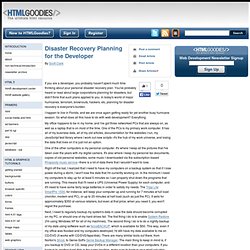
You've probably heard or read about large corporations planning for disasters, but didn't think that such plans applied to you. Disaster Recovery Planning for the Developer, Part 2. In our last article we touched upon the most basic steps that a developer can take to survive and recover from a disaster, be it a hurricane, terrorist attack, ice storm, hackers, virus--any of the typical disasters we could face today or in the future.

In 2005, Hurricane Katrina bought home the reality of disaster recovery, or more precisely, what happens when one doesn't prepare. In this article we're going to take disaster recovery planning to the next level--we're going to discuss the Business Continuity Plan. What is a Business Continuity Plan? The first step in designing your Disaster Recovery Plan is to put together your Business Continuity Plan (BCP). According to Wikipedia, Business Continuity Planning is a "methodology used to create a plan for how an organization will resume partially or completely interrupted critical function(s) within a predetermined time after a disaster or disruption. " Disaster Recovery Planning for the Developer, Part 3. Making a Disaster Recovery Plan for Don's Web Design When we last left off, we had discussed the creation and planning of a BCP, Business Continuity Plan, and a DCP, Disaster Recovery Plan, for your business.
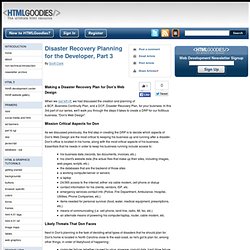
In this 3rd part of our series, we'll walk you through the steps it takes to create a DRP for our fictitious business, "Don's Web Design". Mission Critical Aspects for Don As we discussed previously, the first step in creating the DRP is to decide which aspects of Don's Web Design are the most critical to keeping his business up and running after a disaster. Don's office is located in his home, along with the most critical aspects of his business. Likely Threats That Don Faces. Disaster Recovery Planning for the Developer, Part 4. In our last article we went through the steps of creating a Disaster Recovery Plan for our ficticious business, Don's Web Design.
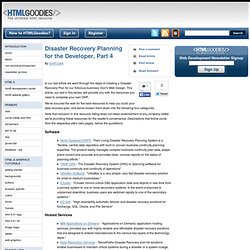
This article, our last in this series, will provide you with the resources you need to complete your own DRP. We've scoured the web for the best resources to help you build your data recovery plan, and we've broken them down into the following four categories. Note that inclusion in this resource listing does not mean endorsement of any company listed; we're providing these resources for the reader's convenience. Descriptions that follow come from the respective site's own pages, hence the quotations. Microsoft Word - 0303 - virtualizatiion_1 - virtualizatiion_1.pdf. Microsoft Word - 0304 - virtualizatiion_2 - virtualizatiion_2.pdf.
Microsoft Word - 0306 - virtualizatiion_3 - virtualizatiion_3.pdf. Stratus Technologies. Integrity NonStop Servers - HP Servers. Xplore Abstract - Fault-Tolerant Computing—Concepts and Examples. Open source high-availability clustering. By Matthew O'Keefe and John Ha Introduction As Linux is used more widely for mission-critical applications, support for high availability through application failover is becoming more important.
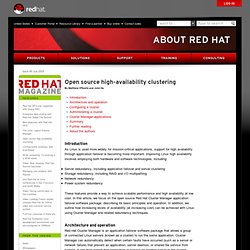
Improving Linux high availability involves employing both hardware and software technologies, including: Server redundancy, including application failover and server clusteringStorage redundancy, including RAID and I/O multipathingNetwork redundancyPower system redundancy These features provide a way to achieve scalable performance and high availability at low cost.
Architecture and operation Red Hat Cluster Manager is an application failover software package that allows a group of connected Linux servers (known as a cluster) to run the same application. Cluster Manager can be used to improve the availability and simplify the management of database (such as Oracle and MySQL), file serving (NFS and CIFS protocols), and web serving (such as Apache) applications. Figure 1. Figure 1. Cluster nodes Note: High-availability cluster. HA clusters are often used for critical databases, file sharing on a network, business applications, and customer services such as electronic commerce websites.
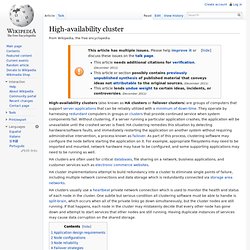
HA cluster implementations attempt to build redundancy into a cluster to eliminate single points of failure, including multiple network connections and data storage which is redundantly connected via storage area networks. Application design requirements[edit] Not every application can run in a high-availability cluster environment, and the necessary design decisions need to be made early in the software design phase. In order to run in a high-availability cluster environment, an application must satisfy at least the following technical requirements, the last two of which are critical to its reliable function in a cluster, and are the most difficult to satisfy fully: There must be a relatively easy way to start, stop, force-stop, and check the status of the application.
Node configurations[edit] Node reliability[edit] See also[edit] The Bathtub Curve and Product Failure Behavior (Part 1 of 2) By Dennis J.
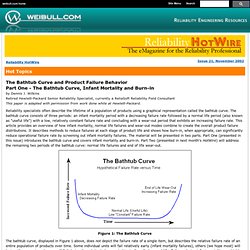
Wilkins Retired Hewlett-Packard Senior Reliability Specialist, currently a ReliaSoft Reliability Field Consultant This paper is adapted with permission from work done while at Hewlett-Packard. Reliability specialists often describe the lifetime of a population of products using a graphical representation called the bathtub curve. The Bathtub Curve and Product Failure Behavior (Part 2 of 2) By Dennis J.
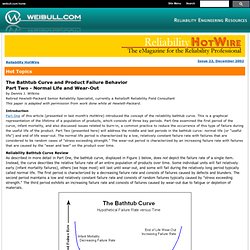
Wilkins Retired Hewlett-Packard Senior Reliability Specialist, currently a ReliaSoft Reliability Field Consultant This paper is adapted with permission from work done while at Hewlett-Packard. Introduction Part One of this article (presented in last month's HotWire) introduced the concept of the reliability bathtub curve. This is a graphical representation of the lifetime of a population of products, which consists of three key periods. Part One examined the first period of the curve, infant mortality, and also discussed issues related to burn-in, a common practice to reduce the occurrence of this type of failure during the useful life of the product. Part Two (presented here) will address the middle and last periods in the bathtub curve: normal life (or "useful life") and end of life wear-out.